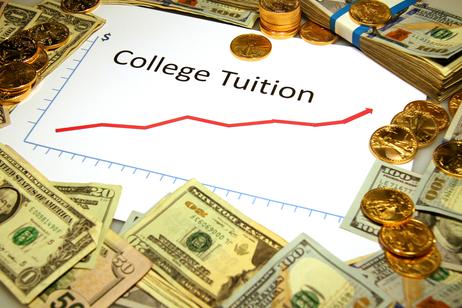The cost of college tuition rises each and every year. Though many students struggle to fund their college education, there are others who are lucky enough that they don’t need to borrow money for school. Even if a high school student doesn’t plan to borrow money to pay their tuition, however, it is still wise to fill out the Free Application for Federal Student Aid (FAFSA).
According to a new report sent out by the National Center for Education Statistics, there are many reasons why high school students fail to fill out the FAFSA, and some of them are due to misconceptions. Keep reading to learn why every high school student should apply for financial aid, whether or not they qualify, regardless of their intention to use it.
What is the Free Application for Federal Student Aid (FAFSA)?
According to recent data from the College Board, the average annual cost to attend an in-state public college is about $25,000. For private colleges, that price doubles to over $50,000. While there are certainly students whose families are wealthy enough to pay for tuition without assistance, most incoming college students require financial aid to fund their higher education.
The Free Application for Federal Student Aid (FAFSA) is the form colleges and universities use to determine a student’s eligibility for federal, state, and school-sponsored financial aid. This includes educational loans, grants, and work-study programs. Even if students only plan to take advantage of state or college-sponsored financial aid, they must still complete the form. Filling out the form requires you to provide information about your expected family contribution to determine your need for financial aid and eligibility.
When it comes to paying for college, filling out the FAFSA is one of the most important steps high school students and their families must take. According to Brad Barnett, financial aid director at James Madison University, nearly all students who fill out the FAFSA qualify for some form of federal financial aid. This begs the question, then, why some students don’t bother filling it out at all.
The Top Reasons Students Neglect to Fill Out the FAFSA
The National Center for Education Statistics recently released a report that provides insight into some of the reasons why students didn’t complete the FAFSA for the previous year. The report also provides other relevant statistics and insight into the challenge of paying for college tuition. Here are a few interesting statistics from the report:
- Roughly 25% of ninth-grade students in 2009-10 did not think that college was affordable.
- For students who were in 11th grade, that number rose to 33%.
- Completion rates for the FAFSA were higher among black students than white students.
- Students whose parents had lower levels of education filled out the FAFSA at higher rates than students whose parents had higher levels of education.
- Public school students filled out the FAFSA at higher rates than private school students.
These statistics raise some pressing questions, not the least of which is why some students choose not to fill out the FAFSA at all. According to the report, 33% of 2009 ninth-graders who reported not filling out a FAFSA believed they or their family could afford tuition without financial aid. Another 32% thought they or their family may be ineligible for aid, and 28% did not want to take on debt.
Here is an overview of some of the other reasons high school students chose not to fill out the FAFSA:
- 23% of students did not have enough information about how to complete the FAFSA
- 22% of students did not plan to attend college after high school
- 15% of students did not know that they could complete the FAFSA
- 9% of students thought filling out FAFSA forms was too time-consuming or too much work
To dig a little deeper into these statistics, about 65% of 2009 ninth-graders who graduated from high school reported that they or their parents completed the FAFSA. Of all 2009 ninth-graders surveyed, 24% did not fill out the FAFSA, 8% did not know whether they or their parent filled out the forms, and 3% didn’t even know what the FAFSA was. The percentage of private high school students who filled out a FAFSA was 73% compared to 65% for public school students.
This video discusses some myths about financial aid and the mistakes that applicants make.
Why Every High School Student Should Apply for Financial Aid
Though some of the students who fail to fill out the FAFSA due to concerns that they may not be eligible are correct in their assumption, this is by no means true for the majority. In fact, over 600,000 students belonging to the class of 2018 were eligible for federal Pell Grants but did not fill out the FAFSA to claim them. For 2018-19 students, a total of $27.5 billion in Pell Grants was distributed to over 7 million students, but $2.6 billion in free money went unclaimed.
The truth of the matter is that high school students have nothing to lose by filling out the FAFSA, and there is much to be gained. All U.S. citizens, nationals, and legal permanent residents are eligible to apply for federal student aid, and even families with higher incomes often qualify for some form of aid. Mark Kantrowitz, a college admissions advisor and financial aid expert, states that there is no explicit income cutoff, and the different types of aid have different criteria for awarding.
Filling out the FAFSA takes time, but it is well worth the effort. You’ll be asked to provide information about income, assets, and various demographic factors. This information is then used to calculate your expected family contribution (EFC) to determine your aid eligibility. Families earning less than $26,000 annually are automatically calculated at zero EFC, qualifying them for a Pell Grant.
Whether you think you qualify for federal student aid or not, every high school student should fill out the FAFSA. Even if you don’t qualify for need-based aid, colleges and universities use FAFSA information to award their own grants and scholarships. You won’t know whether you qualify for aid unless you fill out the FAFSA, and the worst that can happen is that you find out you are ineligible.
Important Information to Know About the FAFSA
The first day an applicant can complete the FAFSA for the upcoming school year is October 1. Deadlines vary from one school to another, but the federal due date to fill out the FAFSA each year is June 30. Some schools have priority filing dates as early as December 1, so if you plan to apply for scholarships and other college-sponsored aid, it pays to complete the form as early as possible.
To complete the FAFSA, students need the following:
- Social security number
- Driver’s license number of state ID
- Tax information
- Records of untaxed income
- Current bank statements and investments
- List of schools they are applying to
Parents will also need tax information, records of untaxed income, net worth and investment information, and current bank statements. To make it easier to fill in FAFSA information, students and parents can access the IRS Data Retrieval Tool (DRT), which automatically transfers tax information to the online FAFSA application. All you need is income tax returns from the prior year.
This video offers ten important facts about FAFSA.
Filling out the FAFSA each year takes time, but it is well worth it for the chance to receive federal, state, and college-sponsored aid for the upcoming school year. All students have the potential to benefit from filling out the application, and there is nothing to lose by applying.
Questions? Contact us on Facebook. @publicschoolreview















